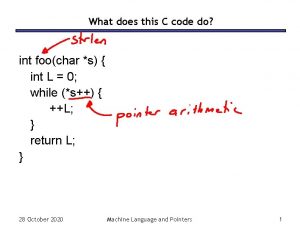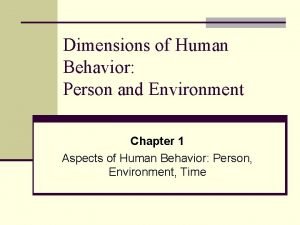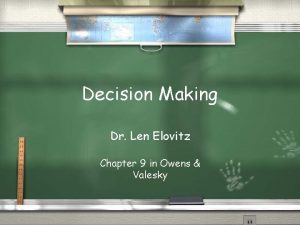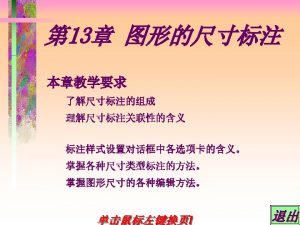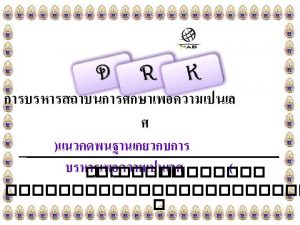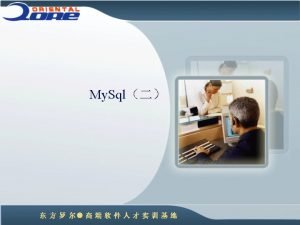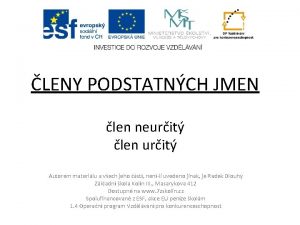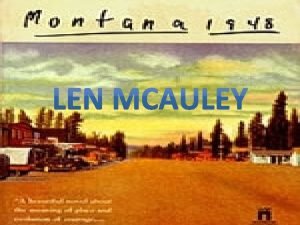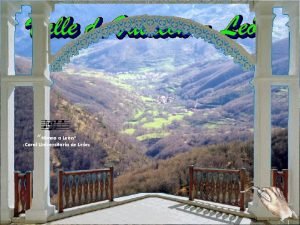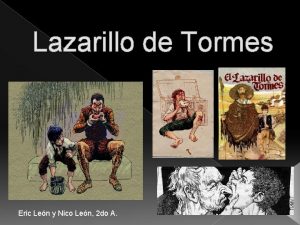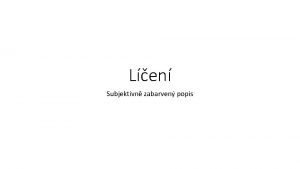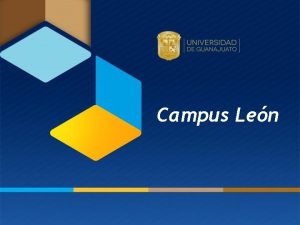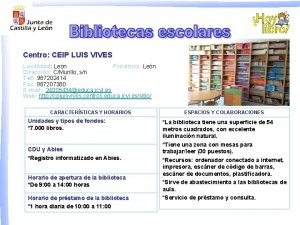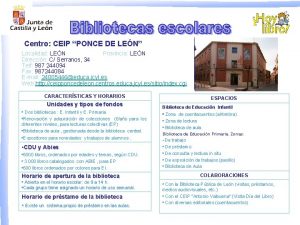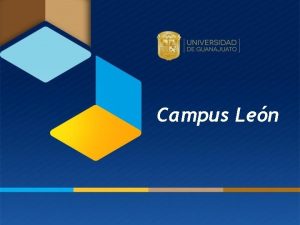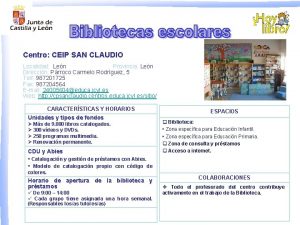The Human Dimension of Organization Dr Len Elovitz


















- Slides: 18

The Human Dimension of Organization Dr. Len Elovitz Chapters 3 &4 in Hoy and Kiskel

The Human Dimension of Organization o Emphasizes the shift from a traditional structural approach to an emphasis on improving the organization from the bottom up. o By building human capital, the organization becomes more effective as individuals and groups increase their capabilities.

Educational Organizations as Loosely Coupled Systems o Karl Weick and James G. March indicated that educational organizations were not composed of hierarchical units as in a true bureaucracies, but are loosely coupled systems. o Loosely coupled systems—subsystems in the organization are related to one another, but maintain their own identity and autonomy (e. g. , the child study team). Copyright © Allyn & Bacon 2007 3

Educational Organizations as Dual Systems o John Meyer and Brian Rowan’s important study early 1980 s confirmed the concept of loose coupling. o Dual systems include: n Loosely coupled system over instruction. n Tightly coupled system over noninstruction (transportation, pay etc). Copyright © Allyn & Bacon 2007 4

Educational Organizations as Dual Systems (continued) o Administrators have control over instruction via bureaucratic means: n The control of time, e. g. , scheduling of teachers and students. n The assignment of students to classes. n Grouping. n Control of resources. o In recent years, since NCLB, studies show that schools are exerting considerable control over instruction. - Neoscientific Copyright © Allyn & Bacon 2007 5

Building Human Capital o Human Capital: the knowledge, skills, attitudes, and social skills of employees. o Education is an investment in human capital. Copyright © Allyn & Bacon 2007 6

o People should be managed so that their skills, attitude and knowledge develop, improve and increase over time rather than level off or decline. o This process develops and increases the value of the organization’s human resources and, hence, builds human capital. Copyright © Allyn & Bacon 2007 7

Human Resources are Valuable o Should be thought of and treated as assets o What do you expect of assets over time? n Appreciate – gain in value o What is thought of teachers over time? n Depreciate – lose value Copyright © Allyn & Bacon 2007 8

Human Resources as Assets o Many organizational problems stem from a negative climate, such as low morale or inadequate effort. o Human resources accounting attempts to quantify human attitudes, motivation, and work behavior. o It is commonplace to assume that human resources decline in value over time, e. g. , teacher burnout. o Researchers have shown that by facilitating personal and professional growth, human resources improve over time. Copyright © Allyn & Bacon 2007 9

o “… it is more likely that in a supportive organizational environment, one that facilitates continuous personal growth and professional fulfillment, teachers turn out to be increasingly effective over the course of time. This fortuitous state of affairs is ordinarily found to exist in schools that are described as highly effective. Creating such a growth-enhancing organizational environment is the responsibility of those in charge of the schools, namely, school administrators. It is the process through which one builds human capital in schools. ” Copyright © Allyn & Bacon 2007 10

The Dark Side of Leadership o Studies by Joseph and Jo Blase show that some school leaders abuse or bully teachers. o Examples o National Association of Prevention of Teacher Abuse reported over 1, 000 members in 2010. o www. endteacherabuse. org o Are teachers being vilified in NJ?

Human Resources Development o Human resources are the most important resources in any organization. o Human capital is a term applied to the ability of workers to perform job tasks. o Organizations become more effective in meeting their goals when they invest in human capital through professional development.

Professional Development o Student learning can be enhanced by improving the knowledge and skills of teachers o One-shot in-service workshops – n Pigeons n Buffet 13

Professional Development o Linda Darling-Hammond has shown that teacher preparation, certification, and professional development are strong correlates to student performance. o Title II of NCLB provides grants for improvement of human resources.

National Staff Development Council Standards o Rooted in practice o Research based o Collaborative o Long term o Aimed at instructional improvement o Aligned with standards and assessments 7 15

Professional Development: Fis sustained over time Fis based on adult learning theory Fincludes inside and outside experiences Fcan be job embedded Fencourages risk taking, creativity and assessment

Roxbury o Curriculum of Teaching I o Summer and first semester o Curriculum of Teaching II o Courses taught by administrators and teachers o Implementation phase o Baby steps 17

The Kirkpatrick Model of Training Evaluation o Level 1 Evaluation—Reaction o Level 2 Evaluation—Learning o Level 3 Evaluation—Behavior o Level 4 Evaluation—Results 18
 Foochar
Foochar Dimensions of human behavior person and environment
Dimensions of human behavior person and environment Process organization in computer organization
Process organization in computer organization Compare and contrast organization
Compare and contrast organization Hát kết hợp bộ gõ cơ thể
Hát kết hợp bộ gõ cơ thể Slidetodoc
Slidetodoc Bổ thể
Bổ thể Tỉ lệ cơ thể trẻ em
Tỉ lệ cơ thể trẻ em Voi kéo gỗ như thế nào
Voi kéo gỗ như thế nào Thang điểm glasgow
Thang điểm glasgow Chúa sống lại
Chúa sống lại Các môn thể thao bắt đầu bằng tiếng nhảy
Các môn thể thao bắt đầu bằng tiếng nhảy Thế nào là hệ số cao nhất
Thế nào là hệ số cao nhất Các châu lục và đại dương trên thế giới
Các châu lục và đại dương trên thế giới Công thức tính độ biến thiên đông lượng
Công thức tính độ biến thiên đông lượng Trời xanh đây là của chúng ta thể thơ
Trời xanh đây là của chúng ta thể thơ Cách giải mật thư tọa độ
Cách giải mật thư tọa độ 101012 bằng
101012 bằng Phản ứng thế ankan
Phản ứng thế ankan
